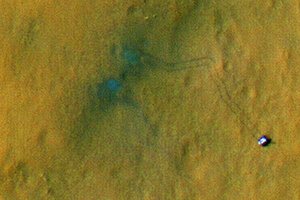Curiosity makes tracks on Mars
NASA engineers high-fived in celebration of the visual representation of their work as seen in new images of the tracks left by the Mars rover Curiosity. The rover is taking a break for a few days while scientists check out some of its equipment.

Tracks from the first drives of NASA's Mars rover Curiosity are visible in this image captured by the Mars Reconnaissance Orbiter. The rover is seen where the tracks end. The image's color has been enhanced to show the surface details better.
NASA/JPL-Caltech/Univ. of Arizona
WASHINGTON
NASA's robotic rover Curiosity is making its mark on Mars, in a way so big that it can be seen from space.
In just one month, it's driven 368 feet on the red planet, slightly more than the length of a football field. Curiosity's slightly zig-zaggy tire tracks were photographed by a NASA satellite circling Mars and also from the rover's rear-facing cameras.
The spacecraft landed on Aug. 5 on a mission to look for ingredients in Martian soil and rocks that could support life.
When the images from the Martian satellite showed the rover tracks, "there was much high-fiving," mission manager Michael Watkins said Thursday. He said engineers were thrilled by the idea that "we left tracks on Mars that we can see from orbit" because it gave them a visible sense of accomplishment.
Other rovers have left tracks on Mars, but not as deep or wide as Curiosity's, Watkins said.
Curiosity won't be traveling any more for several days. Engineers will spend the next week checking out its crucial robotic arm. At the end of that arm is a "Swiss Army knife" of scientific instruments designed to test rocks and the chemicals in the soil, Watkins said.
After the arm and its tools are given clean bills of health, the rover will continue on a trek of more than a week to its first destination, a point called Glenelg, where three types of terrain meet. The rover will likely stop on the way to test its first rocks.
Online: NASA: http://mars.jpl.nasa.gov/msl/

